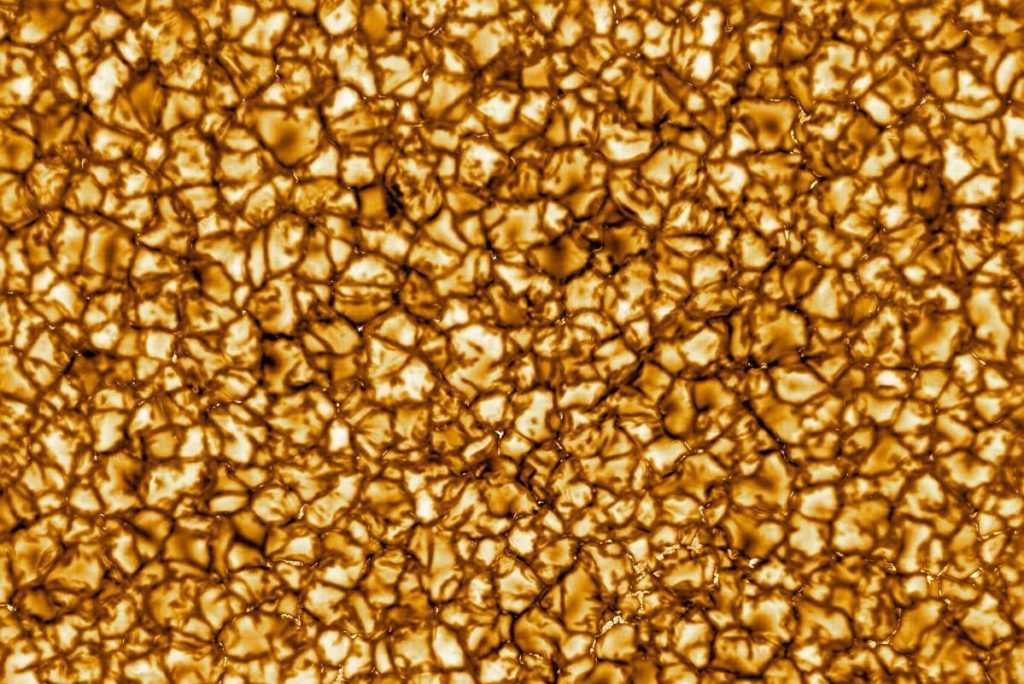
Hi everyone,
[vcex_spacing size=”10px”]
The image above might look like something you’d want to consult a dermatologist about, but it’s actually the most detailed image of the Sun ever taken.
[vcex_spacing size=”10px”]
The new Daniel K. Inouye Solar Telescope (DKIST) recently snapped this amazing closeup of our star. The telescope, located on the island of Maui, is named for the late Hawaiian senator who was a great supporter of astronomy. DKIST’s mirror is four meters in diameter – the same size as Lowell Observatory’s Discovery Channel Telescope (soon to be renamed the Lowell Discovery Telescope). But rather than observing planets, stars and galaxies, DKIST observes the Sun with unrivaled clarity.
[vcex_spacing size=”10px”]

[vcex_spacing size=”10px”]
Although the Sun appears placid to our eyes, it’s actually remarkably active. Sunspots come and go on its surface, flares erupt and fling material into space, and more. Periods of especially intense activity – known as solar storms – can impact our planet by disrupting satellite communications, creating aurora, and even knocking out electrical grids.
[vcex_spacing size=”10px”]

[vcex_spacing size=”10px”]
You can see some of the Sun’s activity for yourself in the time-lapse video below, which was obtained by DKIST. Our Sun resembles a pot of boiling oatmeal as regions of hot material from the interior rise to the surface, while cooler material sinks back down. Each of the ‘cells’ in this honeycomb pattern is about the same size as the state of Texas.
[vcex_spacing size=”10px”]
[vcex_spacing size=”10px”]
And there’s more to come not only from DKIST. A new spacecraft called Solar Orbiter will launch next month to give scientists their first close-up look at the Sun’s north and south poles by flying over those regions. Such observations will improve our understanding of our star and how it works.
[vcex_spacing size=”10px”]

An artist’s drawing of the Solar Orbiter, which will launch on February 7th.
[vcex_spacing size=”10px”]
If you’d like to know more, just click on any of the links below:
[vcex_spacing size=”10px”]
And if you’ve got any questions, don’t hesitate to contact me.
[vcex_spacing size=”10px”]
Best regards,
[vcex_spacing size=”10px”]
[vcex_spacing size=”10px”]
Michael
[vcex_spacing size=”10px”]
[vc_row][vc_column][vc_cta h2=”Feb 20, 2020 Update:”]As of February 2020, The Discovery Channel Telescope (DCT) is now known as the Lowell Discovery Telescope (LDT).[/vc_cta][/vc_column][/vc_row]
[vcex_divider color=”#6D6E70″ width=”100%” height=”4px” margin_top=”20″ margin_bottom=”20″]
 Dr. Michael West is Lowell Observatory’s Deputy Director for Science. Follow his AstroAlerts to receive breaking news stories from the world of astronomy, odd bits of astronomical lore, and information about upcoming astronomical events. You can reach him at mwest@lowell.edu or follow him on Twitter @curatedcosmos.
Dr. Michael West is Lowell Observatory’s Deputy Director for Science. Follow his AstroAlerts to receive breaking news stories from the world of astronomy, odd bits of astronomical lore, and information about upcoming astronomical events. You can reach him at mwest@lowell.edu or follow him on Twitter @curatedcosmos.[vcex_spacing size=”10px”]